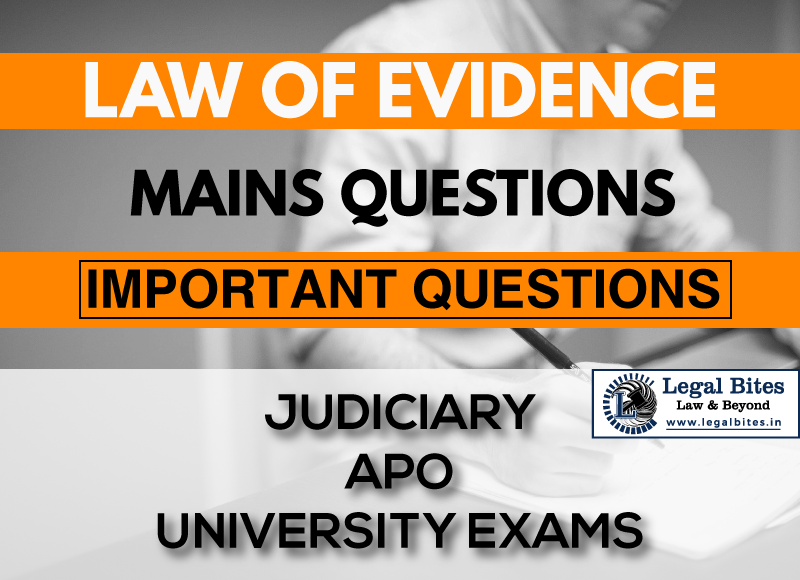“Presumptions may be looked on as the bats of the law, fitting in twilight but disappearing in the sunshine of actual facts”. Explain while discussing, in brief, the different kinds of presumptions recognized by the Indian Evidence Act.
Question: “Presumptions may be looked on as the bats of the law, fitting in twilight but disappearing in the sunshine of actual facts”. Explain while discussing, in brief, the different kinds of presumptions recognized by the Indian Evidence Act. [D.J.S. 1990] Find the answer to the mains question only on Legal Bites. [“Presumptions may be looked on as… Read More »

Question: “Presumptions may be looked on as the bats of the law, fitting in twilight but disappearing in the sunshine of actual facts”. Explain while discussing, in brief, the different kinds of presumptions recognized by the Indian Evidence Act. [D.J.S. 1990] Find the answer to the mains question only on Legal Bites. [“Presumptions may be looked on as the bats of the law, fitting in twilight but disappearing in the sunshine of actual facts”. Explain while discussing, in brief,...
Question: “Presumptions may be looked on as the bats of the law, fitting in twilight but disappearing in the sunshine of actual facts”. Explain while discussing, in brief, the different kinds of presumptions recognized by the Indian Evidence Act. [D.J.S. 1990]
Find the answer to the mains question only on Legal Bites. [“Presumptions may be looked on as the bats of the law, fitting in twilight but disappearing in the sunshine of actual facts”. Explain while discussing, in brief, the different kinds of presumptions recognized by the Indian Evidence Act.]
Answer
The given statement is borrowed from a beautiful metaphor in regard to the judgment of Cochran, J. in Stumpf v. Mantgomery, (1924) 101 OKL 256) as follows:
“Presumptions…. may be looked on as the bats of law, flitting in the twilight, but disappearing in the sunshine of facts.”
From the aforesaid authorities, we hold that once the defendant adduces evidence to the satisfaction of the Court that on a preponderance of probabilities there is no consideration in the manner pleaded in the plaint or suit notice or the plaintiff’s evidence, the burden shifts to the plaintiff and the presumption ‘disappears’ and does not haunt the defendant any longer.
The statement has three canons appended to its meaning:
- The presumption is not evidence but will serve in the place of evidence until prima facie evidence has been introduced by the opposite party.
- The presumption disappears in the face of the testimony of disinterested witnesses “even though such testimony may be in conflict or be disputed”. If the disinterested testimony establishes contributory negligence as a matter of law, under the familiar general rule, the case, of course, will be withdrawn from the jury. If the disinterested testimony does not, however, attain that conclusive character, the issue of contributory negligence will then be submitted to the jury, but without the presumption.
- Where the only opposing testimony is that of interested witnesses or where there is no testimony at all on the issue, “the presumption must go to the jury, together with all the testimony and exhibits properly introduced in the case, unless from all the evidence the court can say that the contributory negligence of the person killed was so evident that reasonable minds could not differ thereon.”
Based upon the above statement, Presumption is categorized generally into two types under the Indian Evidence Act i.e. Presumption of facts (may presume), and Presumption of law (shall presume and conclusive proof).
1. Presumption of facts
Presumptions of facts are those inferences that are naturally and reasonably concluded on the basis of observations and circumstances in the course of basic human conduct. These are also known as material or natural presumptions.
Natural Presumptions are basically instances of circumstantial evidence as it is believed that it is very good to act in the course of reasoning where many inferences can be easily concluded from other evidence otherwise it will keep much ambiguity on the legal system because it will be much more difficult because of the legal system to prove every fact to capture the offenders or law conflicted member of the society. Natural Presumptions are generally rebuttable in nature.
2. Presumption of Law
Presumptions of law are such inferences and beliefs which are established or assumed by the law itself. It can further be divided into rebuttable presumptions (shall presume) of law and irrebuttable presumptions of law (conclusive proof).
Section 4 of the act describes the three terms as-
- “May presume”— Whenever it is provided by this Act that the Court may presume a fact, it may either regard such fact as proved, unless and until it is disproved or may call for proof of it.
- “Shall presume”— Whenever it is directed by this Act that the Court shall presume a fact, it shall regard such fact as proved, unless and until it is disproved.
- “Conclusive proof”— When one fact is declared by this Act to be conclusive proof of another, the Court shall, on proof of the one fact, regard the other as proved, and shall not allow evidence to be given for the purpose of disproving it.
Important Mains Questions Series for Judiciary, APO & University Exams
- Law of Evidence Mains Questions Series Part-I
- Law of Evidence Mains Questions Series Part-II
- Law of Evidence Mains Questions Series Part-III
- Law of Evidence Mains Questions Series Part-IV
- Law of Evidence Mains Questions Series Part-V
- Law of Evidence Mains Questions Series Part-VI
- Law of Evidence Mains Questions Series Part-VII
- Law of Evidence Mains Questions Series Part-VIII
- Law of Evidence Mains Questions Series Part-IX
- Law of Evidence Mains Questions Series Part-X
Admin Legal Bites
Legal Bites Study Materials correspond to what is taught in law schools and what is tested in competitive exams. It pledges to offer a competitive advantage, prepare for tests, and save a lot of money.
